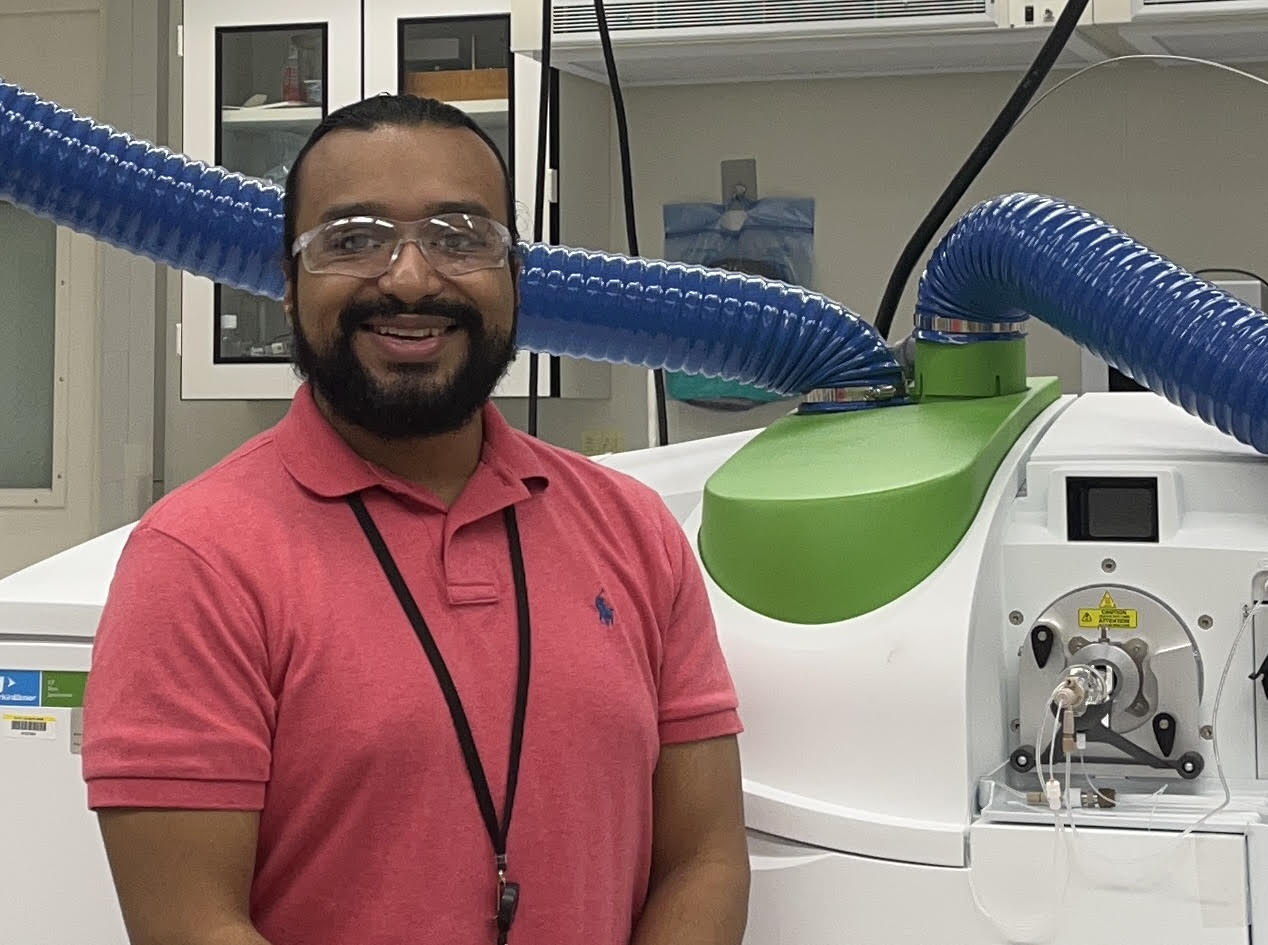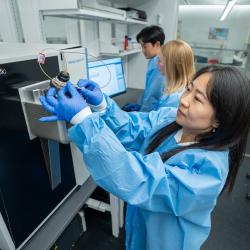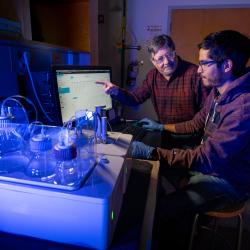Project Plastic
Chemistry Ph.D. student George Caceres puts microplastics into perspective through his mass spectrometry research with the National Institute of Standards and Technology.
When it comes to microplastics, there’s a paradox. These tiny flecks of plastic—some smaller than a grain of sand—have infiltrated every ecosystem on Earth and even human bodies, yet their miniature size and complex structure make them difficult to find and study.
For University of Maryland chemistry Ph.D. student George Caceres (B.S. ’18, biochemistry), the mysteries surrounding microplastics and their little-understood health effects make them a compelling problem to tackle.

“Microplastics are everywhere,” said Caceres, who is also a researcher at the National Institute of Standards and Technology (NIST). “They have been discovered in remote areas of the world and were even recently found in human blood and human breast milk, so there are concerns about accumulation in the environment and the effects that they might have.”
Since 2020, Caceres has been working with NIST to improve methods of detecting and measuring microplastics, which range in size from 1 micrometer (thinner than a strand of spider silk) to 5 millimeters (about the size of a pencil’s eraser). His work could help the wide range of scientists who study the material and its breakdown into ever-smaller pieces over the course of decades or centuries.
Funding for Caceres’ research comes from NIST’s Professional Research Education Program (PREP). A nationwide program, PREP began more than 15 years ago at UMD as a collaboration between the university’s Department of Chemistry and Biochemistry and what is now known as NIST’s Materials Measurement Laboratory.
“PREP was created to strengthen collaborative research and provide unique training opportunities for students and postdoctoral researchers,” said Professor John Fourkas, who directs the program at UMD. “Since that time, the program has expanded to include all of the laboratories at NIST and the entirety of the University of Maryland, College Park. Other universities are involved as well.”
This spring, UMD signed a new five-year cooperative agreement with NIST for $100 million to continue PREP, enabling more postdocs and undergraduate and graduate students like Caceres to receive hands-on training and access to NIST’s cutting-edge lab equipment.
Digging deeper
Caceres didn’t set out to study microplastics. It was his interest in analytical techniques that ultimately led him to NIST and to UMD as an undergrad. He has always been a tinkerer, whether it was stacking Lego bricks as a child or building computers as an adult.
“Since I was young, I was really interested in just figuring out how things worked,” Caceres said. “I wanted to dig deeper, so for my undergrad, I studied biochemistry because I was interested in understanding chemical interactions in the natural world. That’s what got me interested in analytical techniques and shoehorned my way into chemistry."
Caceres started working at NIST in 2015 through the agency’s partnership with Montgomery College, where he studied for two years. As an intern with the agency, he learned a technique to measure trace elements—called inductively coupled plasma mass spectrometry (ICP-MS)—and used it to examine toxic elements in everyday items such as avocados and cat food.
After transferring to UMD, he continued working with NIST as a physical science trainee, then as a research chemist and now as a PREP researcher. His advisors include UMD Chemistry and Biochemistry Professor Sang Bok Lee and NIST analytical chemist Antonio Montoro Bustos, and he works in NIST’s Inorganic Chemical Metrology Group, run by Michael Winchester.
“I have been with NIST for just about eight years now,” he said. “It’s a nice environment, and I owe a lot of credit to the people who helped me along."
Lee said Caceres has been enthusiastic about his research from the beginning and has benefited from the partnerships provided by PREP.
“George’s collaborators in the NIST group led by Dr. Mike Winchester have been superb in providing him with an excellent research environment and great research mentorships,” Lee said. “While his research project is highly challenging in many ways because it's a newly emerging area, I can see he is close to a good research publication.”
‘Part of a solution’
Caceres’ research relies on single-particle ICP-MS, which has broad applications in environmental science and can be used to determine the size, elemental composition and number of particles in a sample. It can even be applied to the tiniest microplastics, setting it apart from other technologies.
“A lot of other techniques that are used to look at microplastics can analyze the 5-millimeter upper range down to something like 50 to 20 micrometers,” Caceres said. “But there are only a couple techniques that can look at the size range that we’re looking at right now. The particles I’m working with are between 1 and 5 micrometers.”

Faced with growing concern over microplastics, researchers are focused on finding new methods of detecting these particles in hopes of better understanding the extent of the problem.
This technique could complement existing research methods that are used to study how plastic particles degrade over time, how they interact with the environment and whether they are toxic to humans and animals. Eventually, single-particle ICP-MS could help estimate the number of microplastics in a particular region or ecosystem, but this method is still in the early stages of development.
Caceres is now adapting single-particle ICP-MS to look for some of the residual elements in plastics, which are mostly made from fossil fuels but can also contain a variety of chemical additives. Metallic additives in plastics—such as cadmium, lead and antimony—can be strong indicators that a sample contains microplastics because these elements are not as naturally occurring as carbon, which ICP-MS traditionally has difficulty measuring.
“A lot of the work that’s previously been done with this technique is looking at the overall carbon signature, which is pretty tricky because carbon is everywhere,” Caceres said. “We hope that by switching to something with a low background metallic signature, we can overcome some of those challenges in our detection capabilities.”
After graduating, Caceres hopes to continue researching microplastics to make an even larger impact. For him, it’s rewarding to be at the forefront of an emerging technology that could help tackle a major environmental problem.
“When I started grad school, there were only a handful of papers that used single-particle ICP-MS to look at microplastics, so it was still very early. Even now it’s still an up-and-coming technique,” Caceres said. “I like the fact that I’m working toward solving a pretty big environmental issue. It’s exciting to be part of a solution.”






